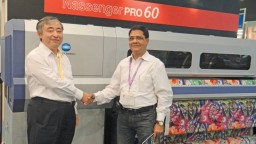
Konica Minolta IJ Technologies Inc. (Konica Minolta), a leading manufacturer of industry-use inkjet print-heads, unveiled new inkjet textile printers, the Nassenger PRO 1000 for significantly high-volume production and the Nassenger PRO 60 for small production, as a new addition to its globally-acclaimed Nassenger inkjet textile printers at the ITMA show.
As the top-of-the-line model of the Nassenger series, the Nassenger PRO 1000 features a number of enhanced functions for high-volume, full-scale production. Utilising 9 colour dye inks, the company claims that the machine is the world’s fastest inkjet printer with a speed of 1000m²/hour at 360 dpi. “With increased speed the quality of the print is always at risk, therefore to address this issue Konica Minolta has developed nozzle sensors and floating-fabric sensors to control quality,” informs Akiyoshi Ohno, President, Konica Minolta IJ Technologies Inc.
With a total of 1024 nozzles, it has an automatic print-head maintenance system unique to Konica Minolta is adopted to ensure stable print production. This system regularly checks the print-head nozzle status to enable stable print quality and uninterrupted production, thus minimizing labour costs by automation. The other innovation – Nassenger PRO 60 has 512 nozzles with a print speed of 60m²/hr. The model uses high-density water-based inkjet print-heads. It also has a 9-colour gamut like Nassenger PRO 1000 and can be used as a proofer for the same. It is compatible with high and low production speeds, ranging from 9-60 m²/hr. Both the printers can handle the maximum fabric width of 1850 mm. This compact machine is an integration of a textile printer, unwinder, dryer and winder with footprint of 20m² approx. Due to the presence of nine 512-nozzle Piezo print-heads, a compact head-carriage design is present in the printer. “The Nassenger PRO 1000 incorporates Konica Minolta’s new KM1024 print-head technology. In addition to reactive and acid dye sets for the Nassenger PRO series, Konica Minolta is also looking to introduce disperse dye inks,” adds Vir Vikram Bhatia, MD, Apsom Technologies.






